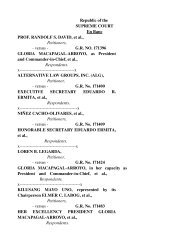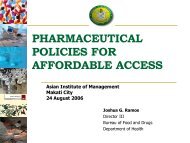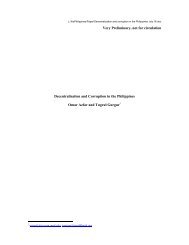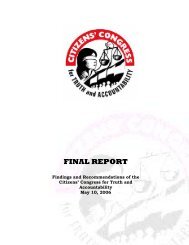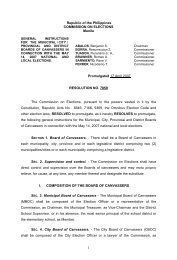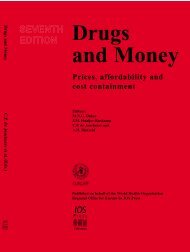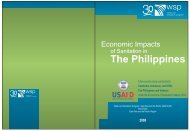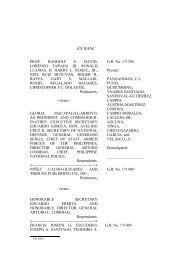The state of water resources in the Philippines - Greenpeace
The state of water resources in the Philippines - Greenpeace
The state of water resources in the Philippines - Greenpeace
Create successful ePaper yourself
Turn your PDF publications into a flip-book with our unique Google optimized e-Paper software.
plants <strong>in</strong> Metro Roxas, San Jose Del Monte, Leyte, Iloilo, Zamboanga, Bongao <strong>in</strong><br />
Tawi-tawi, Pagsanjan, Santiago City <strong>in</strong> Isabela, Albay, and Candon City <strong>in</strong> Ilocos<br />
Sur. Most <strong>of</strong> <strong>the</strong> <strong>water</strong> districts use chlor<strong>in</strong>ation for treatment.<br />
Almost all households <strong>in</strong>cur additional expenditures on <strong>water</strong> treatment and for<br />
bottled <strong>water</strong>. Such expenditures are substantially higher than what is paid to <strong>the</strong><br />
<strong>water</strong> utility. Urban households also spend a substantial amount on bottled <strong>water</strong><br />
as manifested by <strong>the</strong> proliferation <strong>of</strong> “dr<strong>in</strong>k<strong>in</strong>g <strong>water</strong> stations” all over <strong>the</strong> country.<br />
However, “dr<strong>in</strong>k<strong>in</strong>g <strong>water</strong> stations” are <strong>in</strong> need <strong>of</strong> improved regulation as <strong>the</strong><br />
quality <strong>of</strong> <strong>water</strong> does not have to meet any standards at present (Madrazo,<br />
2002).<br />
C. Water shortage and scarcity<br />
NWRB has identified n<strong>in</strong>e <strong>water</strong>-critical urbanized areas where <strong>water</strong> is<br />
consumed <strong>in</strong>tensively. This <strong>in</strong>cludes: Metro Manila, Metro Cebu, Davao, Baguio<br />
City, Angeles City, Bacolod City, Iloilo City, Cagayan de Oro City, and<br />
Zamboanga City.<br />
Cases <strong>of</strong> <strong>water</strong> scarcity and shortages have been documented and reported <strong>in</strong><br />
various publications, among which are <strong>the</strong> follow<strong>in</strong>g:<br />
In <strong>the</strong> summer <strong>of</strong> 2007, a news article reported that <strong>water</strong> suppliers <strong>in</strong> <strong>the</strong><br />
Visayas are fac<strong>in</strong>g supply problems because <strong>of</strong> <strong>the</strong> dry<strong>in</strong>g up <strong>of</strong> <strong>water</strong> sources<br />
due to climatic changes. Accord<strong>in</strong>g to Melchor Bibanco, president <strong>of</strong> <strong>the</strong> Visayas<br />
Association <strong>of</strong> Water Districts, <strong>in</strong> an <strong>in</strong>terview, most <strong>water</strong> districts were<br />
experienc<strong>in</strong>g supply problems, especially dur<strong>in</strong>g <strong>the</strong> summer season. However,<br />
he also observes that this is gett<strong>in</strong>g worse each year. He attributed <strong>the</strong> depletion<br />
<strong>of</strong> <strong>water</strong> sources to <strong>the</strong> El Niño wea<strong>the</strong>r phenomenon as part <strong>of</strong> <strong>the</strong> global<br />
climatic changes (Tupas, 2007).<br />
Same article reports that <strong>in</strong> Iloilo, <strong>the</strong> Metro Iloilo Water District (MIWD) has<br />
started ration<strong>in</strong>g <strong>water</strong> supply to consumers because <strong>of</strong> <strong>the</strong> expected <strong>in</strong>crease <strong>in</strong><br />
demand and <strong>the</strong> low <strong>water</strong> level <strong>of</strong> its source. <strong>The</strong> MIWD extracts <strong>water</strong> from <strong>the</strong><br />
Tigum River through an <strong>in</strong>take dam <strong>in</strong> Barangay Daja <strong>in</strong> Maas<strong>in</strong> town, 29.5<br />
kilometers northwest <strong>of</strong> Iloilo City. It also gets its supply from seven pump<strong>in</strong>g<br />
stations <strong>in</strong> deep wells <strong>in</strong> Oton and San Miguel.<br />
In its report, <strong>the</strong> DENR identified Davao as among <strong>the</strong> major cities <strong>in</strong> <strong>the</strong> country<br />
suffer<strong>in</strong>g from a shortage <strong>in</strong> fresh <strong>water</strong> supply. A critical number <strong>of</strong> communities<br />
<strong>in</strong> <strong>the</strong> second district are perennially suffer<strong>in</strong>g less supply <strong>of</strong> <strong>water</strong>. <strong>The</strong> city <strong>of</strong><br />
Tagum and its nearby towns <strong>in</strong> <strong>the</strong> prov<strong>in</strong>ce <strong>of</strong> Davao del Norte also suffer <strong>the</strong><br />
same problem (Tupas, J, 2007).<br />
From a little over 190 meters by <strong>the</strong> end <strong>of</strong> March 2004, Angat Dam’s <strong>water</strong> level<br />
dropped to a critical mark to 170 meters <strong>in</strong> August due to a prolonged dry spell<br />
attributed to climate change. This prompted government to stop us<strong>in</strong>g <strong>water</strong><br />
reserves for irrigation <strong>in</strong> some areas (Espada, D., 2004).<br />
GREENPEACE | <strong>The</strong> <strong>state</strong> <strong>of</strong> <strong>water</strong> <strong>in</strong> <strong>the</strong> Philipp<strong>in</strong>es 28




